We spend a lot of time, and money, on making our nails look their best. From strengthening treatments to gel manicures, we believe we have them figured out.
The truth is that your nails do more than just provide a means for self expression. There are several ways that your nails are actually trying to communicate information about your overall health if you learn what to watch for!
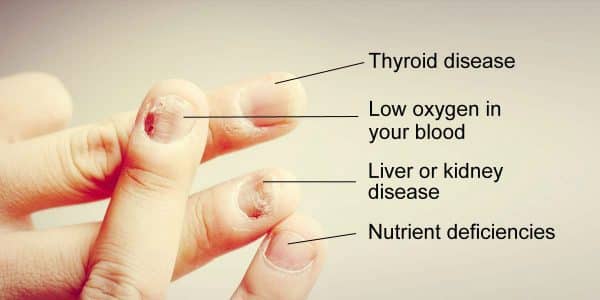
It is important to make yourself familiar with the signs and symptoms of potential health problems. They could be revealing something as small as a minor fungal nail infection, or a much larger health problem like kidney and liver diseases, diabetes, lung and heart conditions or anemia.
It all starts by being more conscious of changes in our nails. Small differences in thickness or shape, swelling and discoloration are all signs that you should consult a dermatologist. Even the rate at which your nail is growing can reveal information about your overall health!
Here are 10 different signs to watch for, and what they mean:
Dry, Brittle or Cracked Nails
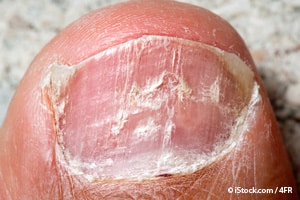
This presence of dry, brittle or cracked nails may be no cause for concern. If you are a swimmer, wash dishes regularly or even use nail polish remover too often you can dry out the nail causing this to happen. Other potential causes include exposure to toxic chemicals on a frequent basis, or living in an area with low humidity. While these are all valid explanations, it could also have a deeper, underlying issue. If you are experiencing a deficiency of vitamin A, B or C it can cause your nails to become brittle. It may also be a sign of thyroid disorder (especially hypothyroidism) or the presence of a fungal infection.
White Spots
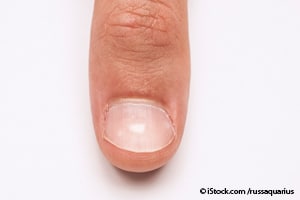
The appearance of white spots on your nail is not something to be alarmed about. In the worst-case scenario, they indicate that you are experiencing a fungal infection, which can be cleared up with a trip to your dermatologist. In most cases, however, they are simply a sign of trauma to the nail and will grow or fade out on their own in time.
White Colored Nails with a Strip of Pink
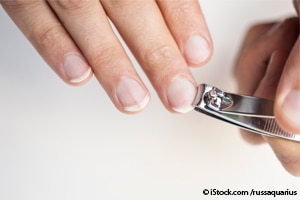
While this could be nothing more than a sign of aging, it is worth a call to the dermatologist if you do notice that your fingernails are presenting themselves as white with a narrow strip of pink near the top. This could indicate congestive heart failure, diabetes, liver disease or kidney failure.
Yellow Nails

Yellowing of your nails can come naturally as you age. It can also be a result of staining from smoking, or from frequent use of either nail polish or acrylic nails. If your nails are presenting as yellow, crumbly and thicker than usual, than you may be dealing with a fungal infection. This could also be a sign of some more serious health complications such as chronic bronchitis, diabetes, psoriasis or a thyroid disorder.
Vertical Ridges
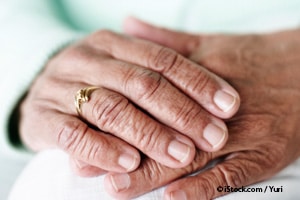
The appearance of vertical ridges on your nails may be a sign that you are deficient in either magnesium or vitamin B-12. However, in most cases the presence of vertical ridging on your nails is nothing more than a sign of aging, which will likely only become more defined as you get older.
Horizontal Ridges
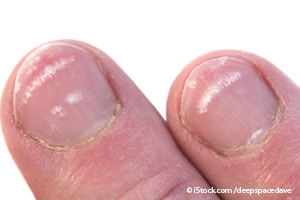
Horizontal ridging can be caused by direct trauma to the nail, so try to recall if you have done anything recently that would fit into that theory. If not, this could be the sign of some more serious health problems. If the appearance of horizontal ridges is accompanied by a high fever, you may be suffering from pneumonia or scarlet fever. If you find they are showing on more than one nail at a time (therefore less likely to have been caused by a trauma) it may indicate circulatory disease, psoriasis, uncontrolled diabetes or a severe zinc deficiency. Horizontal discoloration is also associated with arsenic poisoning, carbon monoxide poisoning, malaria, leprosy or Hodgkin’s disease.
Pitting

If you notice that your nails have many dents or pits in them, this may be a sign of psoriasis. This may also indicate an autoimmune disorder called alopecia areata which has been found to contribute to hair loss, or a connective tissue disorder such as Reiter’s syndrome.
Dark Discoloration
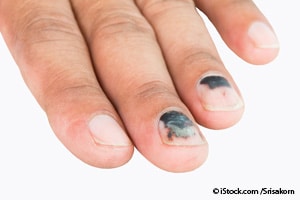
If you notice black streaks or growths on your nail it is important that you see a dermatologist as soon as possible. This may be an indication of melanoma, the deadliest type of skin cancer.
Spoon Nails

If you find that your nails are beginning to curve upward at the edges, creating a spoon like effect, it may indicate that you are suffering from heart disease or hypothyroidism. It may also be telling you about your body’s iron levels, either showing that you are experiencing hemochromatosis (excess iron absorption) or iron-deficiency anemia.
Club Nails

If your nails are beginning to curve downward and grow thicker, this may indicate that you have a low level of oxygen in your blood. Experts have also connected clubbing of the nails to lung disease, AIDS, kidney or liver disease, heart disease and inflammatory bowel disease.
Do You Bite Your Nails? You May be Increasing Your Risk of Infection!
The American Academy of Dermatology reports that the most common nail problem faced by dermatologists is the presence of bacterial infections triggered by nail biting!
When you bite your nails, you cause damage not only to the nail, but also to the surrounding skin and tissue. These small abrasions and tears provide an entry point for bacteria, yeast and other microorganisms. This may result in the appearance of redness, swelling, pus around the nail or a skin infection known as paronychia. In more severe cases paronychia requires surgical treatment.
6 Tips to Stop Nail Biting
Are you guilty of this bad habit? There is no better day than today to start turning it around! Here are 6 tips to help you break free of nail biting:
- Keep your nails trimmed short, or manicured.
- Keep your hands busy using activities like knitting.
- Apply a substance to your fingertips that has an unpleasant taste such as vinegar, hot sauce or store-bought bitter-tasting nail products.
- Use Band-Aids or electrical tape in order to wrap your fingertips.
- Start a journal to track your triggers, such as boredom, watching TV or times of high anxiety or stress. You can then use this information to try avoid said triggers.
- Seek professional assistance, such as with habit reversal training.